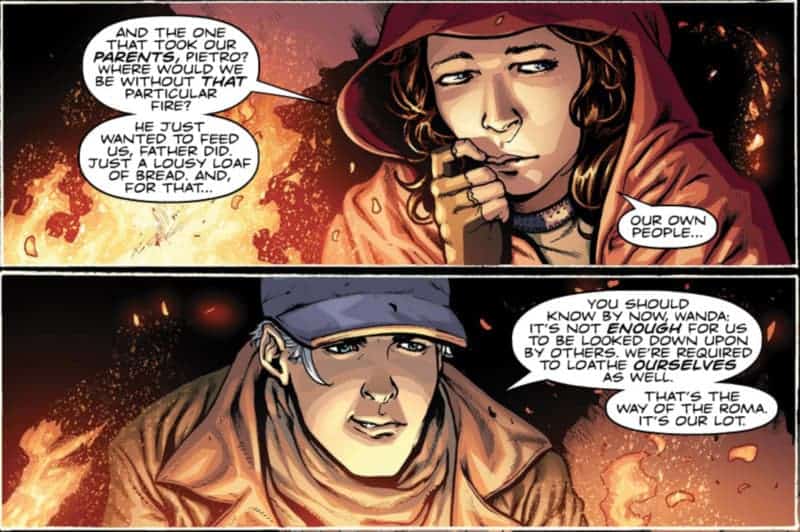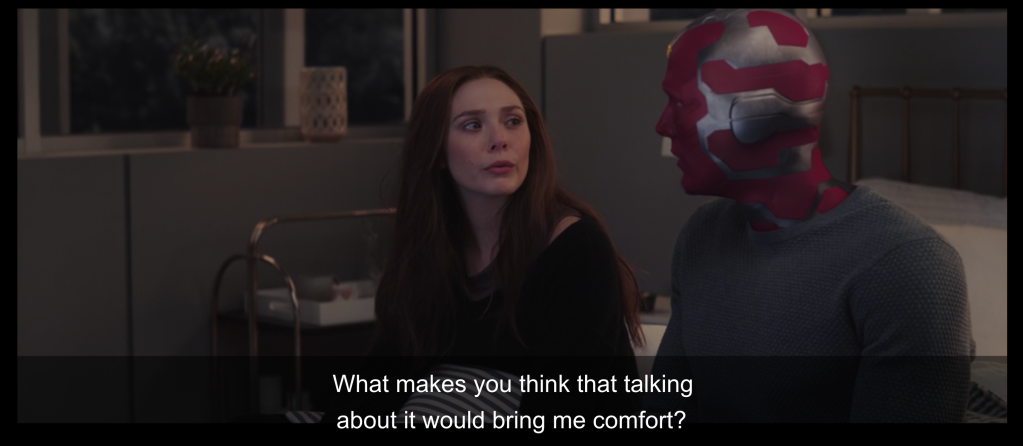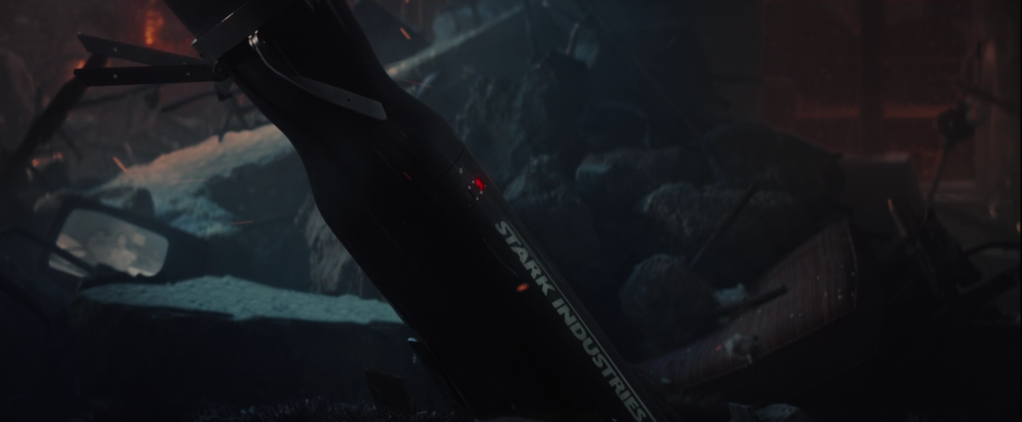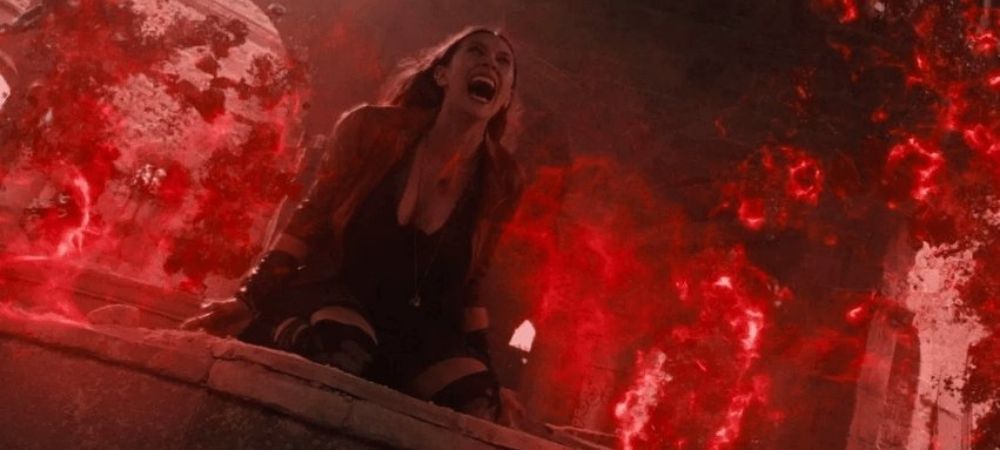By Emma Louise Backe
In the first several episodes of Disney’s new show Wandavision, it’s unclear whether the “bit” of old sitcoms as the framing device will be consequential to the story of Wanda Maximoff post Avengers: Endgame (2019), or simply a whimsical backdrop by which to analyze how Wanda is processing her grief. This grief serves as the implicit backdrop of these first few episodes, switching between the sitcom styles of the 1950s, 1960s, 1970s, until Pietro, Wanda’s dead brother is brought up. It’s the first hint we get in the show that, despite the older stylistic framings of Wandavision (the show within the show), it still exists within the broader timeline of the MCU. This very timeline includes not only the untimely demise of Pietro and the loss of her country in Age of Ultron (2015), but also the death of Wanda’s parents as a child, her genetic experimentation to develop her powers, and the loss of her life partner Vision—a loss she had to enact to kill Thanos and stop him from blipping out half of the universe’s population. Fans enter the show aware of Vision’s death, and the likelihood of Wanda’s traumatic grief, but the campy, domestic setting of the show within the show seems to bracket out this version of reality. As we come to learn throughout Wandavision, the show within the show has been created by Wanda herself, trapping residents of Westview, New Jersey as characters in her family comedy while repelling the military operatives who see Wanda’s simulacrum as a threat. Although the sitcom veneer begins to fall away as this outside world makes itself felt on the borders of Wanda’s version of reality, the dramaturgical conceit of the television show can also be read as a critique of the performativity of grief and trauma. Wanda is trying to learn how to grieve, drawing upon the models of grief we’ve made culturally available, while simultaneously showing us the emptiness, the insufficiencies of the models of trauma and repair we’re typically offered.
The concept of trauma, and traumatic grief more specifically, has become increasingly common in both medical treatment and popular vernacular. The growing “empire of trauma” as Didier Fassin and Rechtman (2009) put it, emerged out of a recognition of the particularly traumatizing effects of war and conflict, and the need to manage political violence and human rights abuses at both an individual and a national level. The atrocities perpetrated during the Holocaust, for instance, necessitated an international tribunal, one during which a history of crimes could be accounted for, a process that would ostensibly facilitate justice and ensure that such an ethnic genocide would never happen again (Agamben 2006; Arendt 2002). Indeed, in the comic books, Wanda’s mother is a Holocaust survivor, although in the show this backstory is not mentioned—the troubling boundaries of “Never Again.” These tribunals derived their power from the testimony of victims and survivors, those who could account and recount what happened. This same process of traumatic testimonials has been taken up as a “best practice” in Truth and Reconciliation Commissions (TRC) in post-conflict settings, becoming “trauma ‘workshops’” (Baer & Sznaider 2015) where collective and individual resolution for hurt is facilitated through the process of providing testimony, and having that testimony born witness to by others.

This model of traumatic healing relies on “a widespread psychological credo holds that unpleasant memories are repressed and that only the truth will set one free” (Baer & Sznaider 2015, 182), that testimonial has an inherently salutary effect on the those who suffer from complex grief. As Eric Stover notes, “The notion that storytelling is healing is based on several psychological studies demonstrating that individuals who repress intense emotional pain can suffer from physical and psychological problems that damage family and other relationships […]. But the mind that fixes on pain risks getting trapped in it. Too horrible to remember, too horrible to forget’” (2005, 29). Initially, we are supposed to understand that this sense of traumatic entrapment is precisely what led Wanda to create this fictional Westview sitcom world in which her brother and her partner are alive. She is failing to confront the terrible losses that she’s suffered through this form of televised escapism.
We see the impulse to get Wanda to confront reality, that the world she’s created is an illusion, through Monica Rambeau (a S.W.O.R.D. agent within the US government) and Agatha Harkness. Wanda’s impulse not to remember serves as a kind of “screen memory,” or falsified memories that we construct as children to protect us from otherwise traumatizing memories (Freud 1899). The show she’s created forms a figurative and literal screen blocking out the memories which cause her such intense grief. Agatha Harkness, another witch in Westview, uses her own magic to break the illusion and force Wanda to confront her memories, she reminds Wanda that it’s “good medicine.” Just as Wandavision is laid out like a sitcom stage, Wanda’s memories, too, are replayed like theatrical set-ups, Wanda and Agatha moving through the recollections like directors and set designers. Recalling a conversation with Vision after her brother died, the two sit side-by-side on her bed in the Avengers compound, a sitcom playing on a screen before them. Vision asks Wanda whether she wants to talk about what she’s feeling—“What makes you think that talking about it would bring me comfort,” she replies. She is essentially rejecting the narrative that talking about trauma in and of itself is healing, that the process of disclosing one’s grief is an inherently curative process. Instead, she’s created a world where no one is truly hurt or gone, because, explaining the conceit to Vision, “it’s not that kind of show.”

We could read Wanda’s hesitancy to talk through Kubler Ross’s Stages of Grief, situating Wanda firmly in the “denial” stage. But Wanda’s grieving process is more complicated than a linear projection of how and when someone should grieve. Indeed, we could examine the dramaturgical elements of her show, and her process of remembering through Agatha’s theatrical guidance, as a critique of the ways that traumatic storytelling is often co-opted and highly managed for purposes other than the recovery of the victim or the survivor. As Michael Humphrey discusses in the context of commissions and tribunals in Chile and Argentina, “There is a whole industry of professionals that has grown up around making trauma visible, making victims visible to others and making victims conscious of themselves as victims. The media play a big role in making victims visible and generating discourses of victimhood” (2010, 39). The process of visualizing victimhood relies on how we produce traumatic stories—these stories must often be legible and chronological, something that can be easily recognized by commissioners or witnesses as “self-evidently” traumatic. This discursive framing does not leave a lot of space for the problematic lapses of traumatic memory, and the cognitive ruptures that can occur due to the neurological consequences of trauma.
But beyond a chronological narrative—tell us the series of events by and through which you came to be traumatized—the ability to tell one’s story also relies upon the very category of who gets to call themselves a victim or a survivor. Victimization is not simply a psychological category—it’s a political one as well, a political position from which you can demand justice and retribution from your government or an international governing body. But because of the political nature of victimization, the stories of certain survivors aren’t “authorized” in these traumatic settings. In the case of the Truth and Reconciliation Commission in South Africa, individuals were only able to identify as victims if their experiences fell into carefully defined categories of human rights abuses (Wilson 2009). The stories of many female South African activists, and women who had experienced gender-based violence during apartheid, were not included in this narrow category of human rights abuses (Ross 2003). Their trauma went unacknowledged, and yet was folded into a larger narrative of collective reconciliation. Women who spoke out about the ways that they had been silenced, their trauma overlooked, were condemned as undermining the transitional justice process, the impulse of national healing through forgiveness facilitated by the TRC. In this case, the format of traumatic storytelling—which promised healing, resolution and justice—failed to acknowledge the silences it precipitated, or the larger political concerns among apartheid’s victims.
In so doing, many have argued that these kinds of traumatic storytelling prioritize collective resolution over individual grievances. Within the narrative frames provided by traumatic testimonials, there is often also a failure to account for the other dimensions contributing to a person’s sense of grief or suffering, beyond the traumatic “event” itself. So while Agatha forces Wanda to confront the eventification of her sedimented and accumulated traumas—as if this process of remembering will reveal a deeper truth about Wanda’s identity and her powers—the frame of these memory shots is often self-contained and singular. We see Wanda’s parents die during an attack on their building, but there is no accounting of why their town was targeted by violence, the role Stark Industries played in arming regional dissidents. We watch as Wanda is exposed to the mind stone in HYDRA headquarters—the only test subject to survive exposure to the infinity stone. But there is no deeper interrogation of the political and economic conditions in Sokovia, and the role of arms trading through US militarism, which led Wanda to volunteer for the experiment in the first place, or the ways that Wanda was trained to be a weapon against the Avengers. Although the bedroom scene between Wanda and Vision takes place in the Avengers compound, the Avengers are noticeably absent in the show. While there were many casualties as the result of Endgame, there is no one from the team to console or support Wanda, no one who seems interested and willing in investing in Wanda as a member of her chosen family.
In fact, throughout most of the MCU, Wanda is perceived of as a threat, the unruliness of her powers a hindrance to the Avengers’ image and bonafides. After accidentally causing a deadly explosion during a mission in Nigeria (Avengers: Civil War), Wanda is essentially placed under house arrest by Tony Stark—the very man whose missile killed her parents and trapped her and Pietro with their corpses for days. Only Vision makes any attempt to support and soothe Wanda, remind her of home with Sokovian cooking. This is after she abandoned Ultron and watched her brother get killed as a consequence of her allegiance to the Avengers. In order to save literally all human life, she has to destroy Vision, the only Avenger with the power to control an infinity stone. And yet, despite all that she has given up for the Avengers, and the residual losses she is forced to bear at the resolution of Endgame, no one is there to comfort her. Her suffering is treated as individualized, and highly gendered—another superpowered woman who can’t control her powers properly. Her previous affiliations with HYDRA and Ultron also mean that she’s not a “perfect victim.” Her innocence, essentially her ability to lay claim to the idealized subject position of trauma, is compromised by her troubled history.

This limited frame by which Wanda is supposed to encounter and heal from her trauma proves all the more counterfeit when we learn that Acting Director of S.W.O.R.D. Tyler Hayward will not release Vision’s body into Wanda’s custody as next of kin. “All that vibranium,” he tells Wanda, hundreds of millions of dollars in advanced technology, would be a waste laying in a grave. Instead, Hayward is dead-set on rebooting the Vision’s system, and turning his technology into another weapon in S.W.O.R.D’s arsenal. It’s not that Wanda is grieving improperly—it’s that her grieving inconveniences his military plans, which is precisely why he frames her for “stealing” Vision’s body. Wanda’s reaction is subsequently deemed irrational and threatening, necessitating intervention by S.W.O.R.D. and the FBI. Wanda refuses to have her grief folded into the military logics of the state, or the idea that protection through militarism represents a kind of care.
Instead, Wanda’s grief is chaotic, subconscious, like her powers as the Scarlet Witch. She’s told by Agatha that her magic is untrained and unmanageable, a danger to those around her. We learn, through the course of the show, that the residents of Westview whom she’s conscripted into her Wandavision plot are indeed suffering—“Your grief is poisoning us,” one tells her once the spell has been lifted. “We have your nightmares when we sleep,” another reveals, agonized by her psychic turmoil. Wanda has unwittingly cast her own tribunal of witnesses, those who are forced to not only see what she’s gone through (the nightmares), but to also quite literally embody and feel the physical pain of her grief. Rather than relying on the story of the traumatic event itself, these residents-cum-performers must experience haptic grief, a kind of sensory solidarity with Wanda. They are the only ones available—though not necessarily willingly—to bear witness to her pain without demanding it be told through a careful and convenient narrative. Wanda has attempted to cultivate a form of traumatic memory and memorialization using her own conventions and rules, after the outside world has failed to recognize her pain or acknowledge the hurt that she’s experienced. She is stuck in a kind of “ethical loneliness” (Stauffer 2018), an injustice that occurs when we fail to hear or acknowledge the suffering of another.
What we are left with is a kind of grief that is simultaneously destructive and generative, manipulating those around her just as she strives to cultivate the stable home life she’d imagined with Vision. By replaying the same days, the same scenes, over and over again through the show, she is stuck in what some have referred to as melancholia, a cyclical form of mourning stuck in past remembering but incapable of moving forward. Historically, this kind of melancholia has been cast as an incorrect or unhealthy way to grieve—one becomes immobilized in the trauma. But others have discussed how melancholia creates alternative kinds of memorializations for the dead (Garcia 2010), and can, in some circumstances, create new kinds of social solidarity and support for the aggrieved (Ralph 2017).
It’s this absence of social support or recognition of Wanda’s pain that makes the decision she makes in the season finale ring somewhat hollow. We’re supposed to believe that Wanda decides to end the televised world she’s created to release the residents of Westview she’s kept captive as actors in her personal drama. Yet, in breaking the spell, Wanda also loses Vision and the sons—Billy and Tommy—she’s had with Vision, the very family she sought to protect. Returning to Kubler Ross’s “Five Stages of Grief” Theory, Wanda’s decision could represent reaching the stage of acceptance. She never got to say goodbye to Vision in Avengers: Endgame, or lay his body to rest. The world she’s created in Westview allows her to potentially get resolution to the sudden and complex grief she’s suffered since Vision’s demise. Yet resolution from traumatic grief also requires “a fundamental change to the social order which made possible the original trauma of crimes against humanity. In this sense, justice remains the event yet to come” (Stover 2005, 15). No such change in the social order has occurred. Indeed, more often than not, “Victims often point out that they are being asked to bear the burdens of peaceful transition – they give the testimonies, they are asked to forgive, and they get little recognition or material compensation” (Humphrey 2010, 43). The plot of land Vision bought in Westview to build a home with Wanda remains abandoned. Wanda must go into hiding, fully realized, now, as the Scarlet Witch.
In Episode 8, Vision tells Wanda, “What is grief if not love persevering?” Despite the poignant sentiment, the line was quickly lambasted online by fans. I don’t think the line was mocked because the sentiment is untrue—I found my eyes welling up during this particular scene. But the problem is that grief is not just love. Grief, as Wanda demonstrates, is also anger, terror, sadness, and pain. When we reduce grief only to love, we yet again ignore and silence “negative” emotions associated with grieving—we tell those in grief that how they are feeling is wrong, incorrect, and even alienating. “Good grief” is acceptance, not raging against the dying of the light. Other comic book characters—namely men—are entitled to build their entire sense of identity around familial grief (Batman) or vengeance (The Punisher). But instead superpowered women are continuously cast as the villain (Dark Phoenix, Mystique, even Flame Princess in Adventure Time) because their anger, while often justified, is perceived as a threat. I wish Disney had let Wanda Maximoff keep her anger and her pain, rather than tidily burying her grief. Yet another reminder how our limited frames of grief continue to limit how we’re allowed to process loss, and who we hold responsible for the dead.

Works Cited
Agamben, Giorgio. Remnants of Auschwitz: The Witness and the Archive. New York: Zone Books, 2002.
Arendt, Hannah. Eichmann in Jerusalem. New York: Penguin, 2006.
Baer, Alejandro and Natan Sznaider. “Antigone in Leon: The drama of trauma politics.” In
Routledge International Handbook of Memory Studies. Taylor and Francis Inc, 2015. Pgs. 181-192.
Fassin, Didier and Richard Rechtman. The Empire of Trauma: An Inquiry Into the Condition of Victimhood. Princeton: Princeton University Press, 2009.
Freud, Sigmund. “Screen Memories.” In The Uncanny. Penguin Modern Classics, 1899.
Garcia, Angela. The Pastoral Clinic: Addiction and Dispossession Along the Rio Grande. Berkeley: University of California Press, 2010.
Humphrey, Michael. “The Politics of Trauma.” Arts: The Journal of the Sydney University Arts Association 32 (2010).
Ralph, Laurence. “Becoming Aggrieved.” In Unfinished: The Anthropology of Becoming, edited by João Biehl and Peter Locke. Durham: Duke University Press, 2017.
Ross, Fiona. Bearing Witness: Women and the Truth and Reconciliation Commission in South Africa. Pluto Press, 2003.
Stauffer, Jill. Ethical Loneliness: The Injustice of Not Being Heard. New York: Columbia Press, 2018.
Stover, Eric. The Witnesses: War Crimes and the Promise of Justice in The Hague. Philadelphia: University of Pennsylvania Press, 2005.
Wilson, Richard. The Politics of Truth and Reconciliation in South Africa: Legitimizing the Post-Apartheid State. Cambridge: Cambridge University Press, 2009.





[…] mother made manifest in Wanda Maximoff, now Scarlet Witch. Despite the deeply felt and nuanced critique of grief, abandonment and complex trauma offered by WandaVision—a show that explored the “ethical loneliness” (Stauffer 2018) that occurs when one’s grief […]
LikeLike
[…] Screen Memories, Scarlet Witch & the Complex Grief of Wandavision by Emma Louise Backe […]
LikeLike